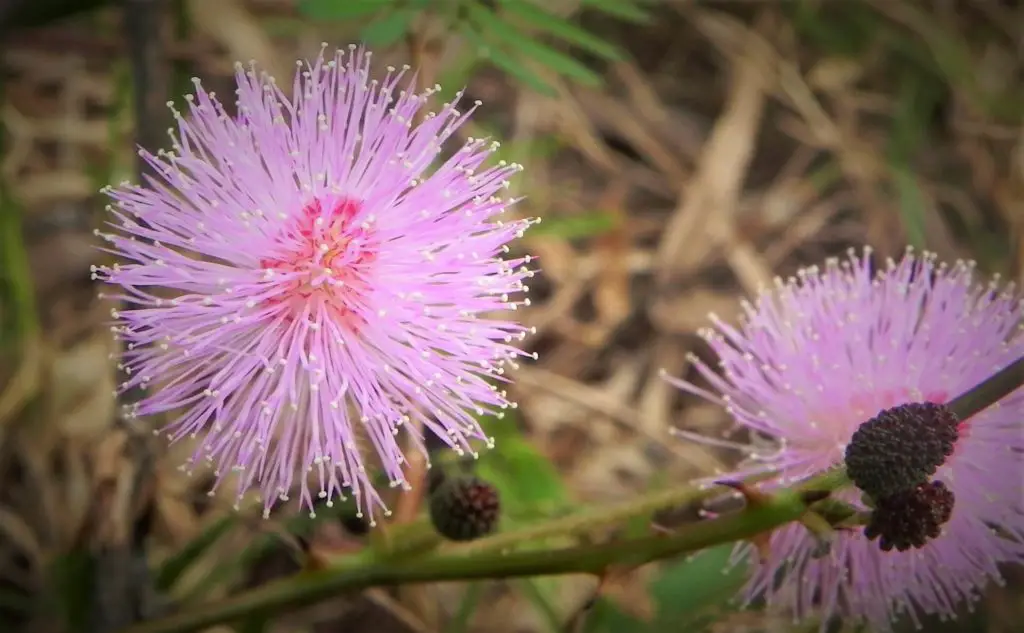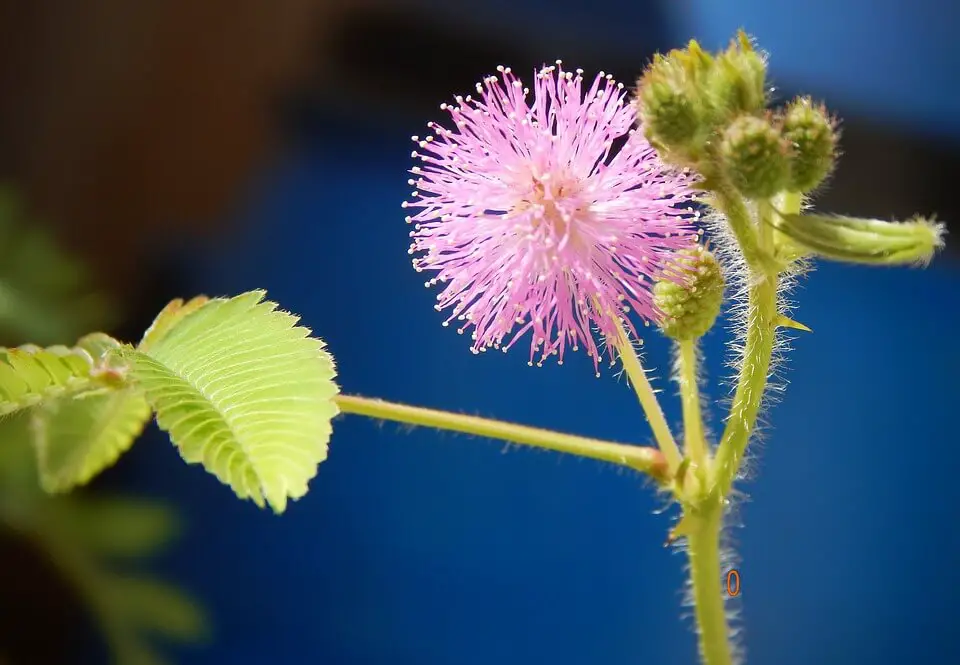Touch me not plant (Mimosa pudica) is a plant full of shyness under its protectiveness is a masterpiece of nature.
People find this plant fascinating due to its shy nature of closing and opening leaves.
As it is said, “Plants are social organizations,” so this Touch me not plant is the real face of it.
You can also easily grow this plant by following this article.
Here you will get an easy way to grow and propagate with care, uses, and all amazing facts and information about this happiness-giving plant.
Key Learning Points
Further Reading:
What Kind of “Touch Me Not Plant” Is?
Have you ever heard plants moving? You must hear but would never have seen.
Touch me not plant (Mimosa pudica), a shy sleeping plant that people love to grow, is due to its fascinating movements.
Its Fan like movements gives them a happy smile.
Mimosa pudica is native to Tropical South and Central America. Growing this sensitive plant is fairly easy as it doesn’t require any sophisticated conditions.
It can easily grow indoor when you start with a cozy environment.
The plant is perennial, 30-40 cm in height, but is usually grown as annual because it is not so easy to keep it alive in winters but, if managed, you can have plenty of seeds.
Touch Me Not Flower
Mimosa pudica is a shrubby annual and perennial plant with a fluffy ball-like pretty pink flower that blooms all the way. Hundreds of fine filaments make flowers bloom.

Touch Me Not Plant Leaves
Likewise, with pretty pompom-like pink flowers, this sensitive plant has amazing sets of leaves that fold up when getting a stimulus of touch; by an individual, an insect, or strong blowing wind.
They find it disturbing and dangerous.
Every time touched, their leaves droop on the stem in a synchronized way that recovers after a few minutes when it feels danger is gone.
Young plants give the quickest movements in bright sunshine.
Their leaves fold up at night to sleep, that’s why they called sleepy plants as is sleeping beauty.
Touch Me Not Plant Scientific Name – Renowned Common Names
The scientific name of Touch me not plant is Mimosa pudica.
Just like nicknames of individuals due to certain characteristics, this plant also has certain names that depict its characters as well as love with this plant.
- Sensitive plant
- Action plant
- Sensible plant
- Humble plant
- Shameful plant
- Chuimui
- Amourette herbe
- Lojjaboti
- Prayer plant
You can also have a fun experience touching its feathery leaves. Kids love cuddling sensitive plants.
How to Grow Touch me Not Plant ??? Use Touch Me Not Seeds
Growing touch me not plant (Mimosa pudica) is so easy and fun-loving even kids can also enjoy growing with amazing touch me not kids gardening kit.
This plant is a specific houseplant that you can grow indoor using seeds. They do not need many pampered conditions that you can easily provide.
Get Touch me not plant seeds here:
Growth Requirements: 6 Requirements You Must Follow
Here are some important requirements you must fulfill to grow Touch me not plant
1. Potting Soil
The first, most important thing is the soil in which seeds are grown. Mimosa pudica can grow easily in any type of soil but grows best in moist and well-drained soil.
You can use commercially available potting soil or indoor potting mix but if you want to make it on your own, it is very easy. You have to mix two parts peat moss, two parts loamy soil, and one part builder’s soil.
If you will do this way, you will get the best soil.
2. Pot Selection
As sensitive plants like moist soil grow, self-watering pots are best for their growth.
One more important thing you must keep in your mind is that the pot must contain holes so that the soil cannot get soggy.
3. Proper Light Source
Sensitive plants require bright light. If they are not in proper light, their leaves will get fold and will never be able to recover.
That is why if you are growing indoors, place them in the window that receives direct sunlight (an east-facing window is ideal) for proper growth.
Artificial lighting e.g. full-spectrum fluorescent lighting can also be used if proper sunlight is unavailable.
4. Temperature and pH of Soil
Place this plant in a warm temperature to grow easily. It requires a 20-23oC (75-85o F) temperature.
pH 6-7 is best suitable for its propagation.
5. Watering
Give proper water when the plant is in a growing phase but reduce in winters.
6. Fertilization
Fertilize the plant after regular intervals of time. Use best all-purpose liquid fertilizer once a month for proper growth.

Grow Your Plant- 3 Steps Easy Way
After considering all requirements for the growth of Mimosa pudica, here is simple three steps practically beneficial way to grow touch me not plant:
1. Soak the Seeds
Soak the seeds in a container full of warm tap water for few hours so that seeds can sprout faster. By soaking, the outer tough seed coat weakens and helps to sprout fast.
Before soaking seeds of Mimosa pudica, choose the best appropriate planting time.
Spring is best for planting indoors. If you have good temperature and light control, you can grow at any time.
2. Plant the Seeds
After soaking the seeds, transfer them from the container of warm water to the potting soil mixture. Plant the seeds almost 1/8th inch of the soil and place them in a warm place.
Wait to sprout after covering it. It may take a week.
3. Get Plants
After a week or two, you will get young plants.
Propagation
To grow new plants from mature is quite easy. What you have to do is to follow the simple guidelines and you will get new plants.
- Cut a shoot from the mature sensitive plant.
- The selected shoot must have at least one node on it and a size ranging from 10-12 cm (approximately 4 inches) is most appropriate for propagation.
- Take the potting mixture in a pot and make a small hole by digging.
- Now place the shoot in it and fill in the hole.
- Cover the top of the pot with a plastic sheet to make a humid environment so that the shoot can grow easily.
Have a check on the soil condition and temperature. Make sure the soil is moist but not soggy. If it is dried, give it water on a regular basis and maintain temperature as well.
You can get Mimosa pudica here and enjoy propagation.
Touch Me Not Plant Uses – Top 7 Medicinal Uses
- The problem of excessive urination can be solved with the paste of the leaves of this plant. Apply the paste of the leaves on the lower abdomen. It will give good results to reduce excessive urination.
- It is also beneficial to treat insect bites. Make a paste of leaves and stem and apply on the affected area twice a day.
- If you are having high blood pressure, you can try it but also take medicine side by side.
- Mimosa plant is highly beneficial to treat hair loss and baldness. It helps in the growth of new hair cells and certain shampoos are also available containing extract of this plant.
- Touch me not plant has anticonvulsive properties and is widely used in traditional African medicine.
- Mimosa plant has anti-viral, anti-fungal, and anti-microbial properties and is widely used to treat infections.
- This plant also has anti-venom and anti-inflammatory properties.
Mimosa pudica Care
Caring for Mimosa pudica is not difficult. You can have much with little effort. Here are some caring tips you should follow to care for your sensitive plant:
Disease Control
As plant require moist conditions to grow that is why it is susceptible to fungal attack. Your lovely touch me not may be attacked by aphids and scales so, do not overwater and have a proper check on it.
Pruning
After the flowers bloom, remove dried leaves and shorten stems so that too-long stems would be no longer their part.
Thorns Removal
Mimosa pudica contains thorns that may hurt you. You must remove them so that they can not damage your hands and in this way, the plant will be safe.

Mimosa pudica: 10 Amazing Facts You Must Know
- This plant is exceptionally significant against cobra venom. The aqueous extract of its roots is beneficial in neutralizing the poisonous effects of the monocled cobra.
- “Mimosa pudica” the Latin name of Touch me not plant arises from its unusual habit to shrink its leaves when touched (“Pudica” means “bashful”)
- The rate of seed production is quite high as it can produce over 600 seeds per year. This high amount of seeds is because of their extensive growth.
- The plant closes its leaves at night and opens in the day. It also sleeps!
- The Alkaloid Mimosine, a toxic compound when used in high amounts, is present in Mimosa pudica. So, avoid consuming it in high doses.
- The plant shows Thigmonastic movements when getting touch stimulus.
- Mimosa blooms during the summer.
- This sensitive plant has a beneficial effect over other plants. It lives in symbiosis, a beneficial relationship with nitrogen-fixing bacteria, as a result, the soil is enriched with nitrogen and bacteria get food from plants.
- Mimosa plant protects itself from predators but never attacks and gets rude like carnivorous Venus Fly Trap. It just eliminates annoying insects and hides from people disturbing it.
- It may be grown as an annual plant; having a life span of one year or a perennial plant with a life span of over two years.
Also, know about amazing flowering
Science Behind – Why Mimosa Plant Closes When Touched?
One can think why sensitive plants show movements? Whether they have a brain or any type of reflex system?
It remained a mystery from early times and scientists are showing great interest to explore this. But the fact is they are not having any type of brain.
As far as the science behind the opening and closing of plant leaves is concerned, it is found that specialized hinge-like structures called “Pulvinus” are present in leaves that contain oppositely working motor cells.
When leaves recognize stimulus, they release chemicals that cause water to flow out of the motor cells on one side of the pulvinus and into matching cells on the opposite side.
As a result, turgor pressure changes cause cells to collapse and expand giving plants fan-like movements upon touch or other stimuli.
Sensitive plants also exhibit learning behavior on the continuous application of external triggers. This amazing learning behavior was shown by Mimosa pudica in experiments when scientists sprinkled water on plants.
They responded the first few times but stopped responding after the experiment was performed few more times.
An interesting thing about the experiment was that the same plants were sprinkled with water after one month and they did not show a response. Plants showed learned behavior.
They found it safe.
So, in light of all the above facts and information, it would not only be easy but also very interesting for you to grow this shy and sensitive “Touch me not plant”. Hope this article provided all that you were looking for.
Now you can grow pretty flowers containing beautiful plants and have fun seeing its nastic, sleep-awake movements.